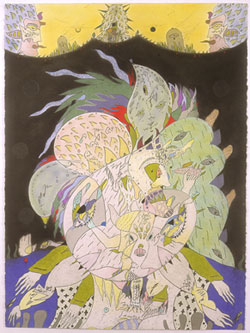
I ask Fields about which spirits specifically are represented in this and other Illuminations works, and whether they ever take on the likeness of real people in his life.
“Most are Mercury sprits,” Fields tells me, referring to the belief system of hermetic science, which places emphasis on spirits associated with the planet closest to the Sun. “They have their own unique physical shapes…but no being or spirit stays in one form forever. Everything is constantly changing and transforming.”
Fields does not attribute a definitive sexuality to any of the spirits represented in his work and rather considers most all to be androgynous, maintaining a necessary balance between masculinity and femininity. He says he connects to his own feminine side, and consistently finds himself drawn to female occult systems and practices such as pagan goddess rituals and the writings of Theosophy founder H.P. Blavatsky.
Fields also cites feminist art as informing his practice, and names Judy Chicago, whose 1970s piece The Dinner Party he considers “the most important feminist art piece,” as a major influence.
Fields attributes much of his receptivity to his proximity to Pilot Mountain, a mountain of resistant rock that has survived millions of years and Fields considers a “cosmic energy center.
As with femininity and masculinity, Fields perceives both “light” and “dark” sides to his work. Though he identifies more with the light and engages with spirits and teachers that are “pure hearted,” Fields does recognize some of his drawings to be “ferocious,” and accepts that there can be no light without darkness.
In Night Shade (2005, shown above), an example of a darker work, Fields’ usually screamingly bright palette dims significantly — with deep charcoals and pallid purple tones — and far less activity fills the frame. Wearing a dark suit coat or robe, the central figure possesses multiple skeletal heads, each with gaunt, shadowed eyes.
 The heads all orient to the left toward a spiraling vortex with a black sun in the center. On the right side of the composition is a Taoist-like symbol of balance.
The heads all orient to the left toward a spiraling vortex with a black sun in the center. On the right side of the composition is a Taoist-like symbol of balance.
Though Fields has experimented with hallucinogenic drugs and credits them with helping him reconnect to the spirits after a long absence during his teenage years, he currently abstains from all mind-altering substances, so as not to interfere with the visions that now come clearly and consistently about twice a week. (However, Fields cannot predict when the visions will come, and they are so intense that he no longer feels safe driving a car; he twice crashed at full speed due to the onset of a vision.)
When asked whether he believes that certain geographical locations are more conducive to spiritual communion, Fields says he attributes much of his receptivity to his proximity to Pilot Mountain, a mountain of resistant rock-quartzite monadnock that has survived millions of years and Fields considers a “cosmic energy center.”
Called Jomeokee by the native Saura Indians, who recognize its sacred properties, Pilot Mountain appears on the horizon line in many of Fields’ works, and is the focus of a few, including Spirit of Jomeokee (2003). Fields visited Pilot Mountain endless times growing up and can always see it in the distance — about twenty-five miles away from the magical house where the spirits first contacted him and can find him still today.
– Amber Whiteside
